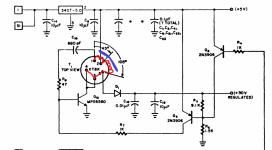We unsoldered it and tested the Hfe in using the DVM and it was only 11.
Looking at the circuit, this does not surprise me at all. Some interesting research work was done by Motorola demonstrating that if you zener the B-E junction of a transistor, it ultimately causes it to experience a drop in hfe.
I have attached a circuit showing the likely internal configuration of the transformer.
One way to analyse this particular circuit is to think of it as a single ended Royer Oscillator (a type of multivibrator) where one transistor and its associated components have been removed, shown in the attached diagram in RED ink, so ignore that, it is conceptual, however it helps to explain what happens with the transistor in your circuit during part of its operating cycle, the part where the transistor is turned on and conducting. For this part of the cycle (assume turns number N1 = N2), the transistor Q10 is biased into initial conduction by the 1k resistor (from the feedback circuit), 5v is applied across winding N1, the current in N1 starts to increase. 5V appears across N2, which adds to the 5V supply, it appears on pin 1 of the transformer as +10V. This charges the 680pF capacitor quite rapidly, and that charge current, reinforces the base current of the transistor Q10. Q10 is switched on. However, the base current starts to fall away as the 680pF capacitor charges, at a certain point there is not enough base current to keep Q10 in saturation, so its collector voltage rises. As that happens the rate of change of current in the primary winding N1 starts to fall, so the induced voltage in N2 falls further weakening the base drive to Q10. Q10 therefore rapidly comes out of conduction. Terminal 1 of the transformer has a voltage that now swings towards ground. Because the 680pF cap was near fully charged on the moment before this happened, even with pin 1 near ground, the base of the transistor will have a negative voltage.
If it was a circuit with the imaginary transistor in Red was present, then the next half cycle would just be a mirror of the first one and easy to analyse. However, without that transistor, when Q10 is cut off, the voltages you will see result from the previously stored magnetic energy in the core, that field collapsing, as the transformer rings with its own inductance and self capacitance determining the frequency and the peak voltage too. The voltage level you get on the collector of Q10, therefore when it is cut off, is a high voltage positive pulse, stepped up a little more by winding N3, which is then peak rectified to charge the filter capacitor Cf.
As Dwight noted before it is a type of flyback supply.
Also during the time that a positive going pulse is present on the collector terminal on pin 4, a similar magnitude negative pulse appears on pin 1 and will go below ground and the B-E junction reverse biased. If that is over about 7 to 10V it could zener the transistor's B-E junction. After a while the current via the 1k resistor will discharge the 680pF and ultimately turn the transistor Q10 on again damp the oscillations of the inductor and restart the cycle.
If you could measure the inductor's self resonant frequency (which takes its self capacitance into account), and its primary inductance between pin 2 & 4, and the peak voltage on pin 1, 4 and 5, it would be dead easy to make one with the correct properties and turn's ratios.




